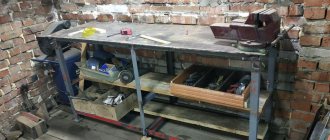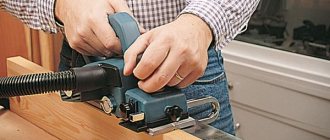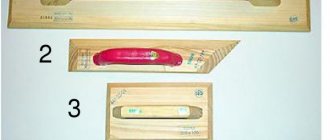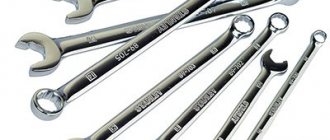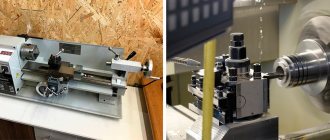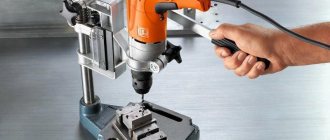A well-equipped locksmith workplace by default implies the presence of a workbench. There are many different models and among them you need to choose the most suitable option for your specific conditions. So, how do the models on the market differ and what are their advantages?
An equipped workplace is necessary for everyone who is engaged in metal processing at an amateur level or professionally. Regardless of the frequency of use, the equipment must be functional, reliable and durable. A metalworking workbench best suits the stated requirements. It is indispensable in all cases where metal processing is planned.
A metal workbench is a specialized table designed for performing metal work. An experienced specialist, of course, has a clear idea of what a locksmith’s workbench should ideally be like. Next, we will consider the equipment options produced today, their features and advantages. Let's figure out which of the existing models is more suitable for professional use and which one is more suitable for amateur use.
Workbench requirements
A master professionally engaged in metalworking does his work only in a specially equipped place. Comfortable conditions and safety will be ensured only if there is a workbench. And, according to practicing experts, it must meet a number of requirements:
- large margin of safety and reliability. It is important that you can work in intensive mode or with large, heavy workpieces;
- maximum functionality and thoughtful ergonomics. A well-organized workplace, where everything necessary for work is always at hand, is a prerequisite for production efficiency;
- sustainability. When you have to work with heavy components, this requirement is mandatory for safety. Without a stable table it is impossible to ensure high accuracy of work;
- immunity to aggressive compounds and other influences. A bench made from high-quality materials lasts for several decades.
Height calculation
The optimal height of a workbench in a garage is calculated based on the person’s height and the main direction of work. For stationary height parameters, for ease of use, footrests are made in the form of a wooden sheathing.
Drawing of a two-tier model
When calculating the drawings, you should take into account the thickness of the table top, distances for welding fasteners, the length of the rolling supports, and the height of the equipment. Without taking these points into account, the distance to the tabletop from the floor increases by 3–4 cm.
Garage table with drawers
To make a carpentry workbench, the optimal height size for work is selected according to the formula:
Design and purpose of a metalworking workbench
In order for a workbench to be truly reliable, durable and practical, its design needs to be worked out in detail. The supporting frame is made of steel. The tabletop is cut out of dense MDF 30 millimeters thick and covered with galvanized iron on top. Such a surface perfectly tolerates any load - dynamic and static. Hammer blows, welding splashes - all this will not affect such a tabletop in any way.
Spilled oil, solvent, gasoline and other mildly aggressive compounds do not react with countertop materials. In addition, the materials do not require any special care - only cleaning the workplace upon completion of a certain stage of work. To enhance the protective properties of the surface, it is recommended to apply powder paint.
It is desirable that the tabletop have edges around the perimeter. Then it will be easier to work with small parts that will not fly off the table. It’s good if the package includes a perforated screen. In this case, there will be a place for attaching the necessary tools - a hammer, a hacksaw, a screwdriver, pliers and various devices. Even more convenience in terms of storing available materials and tools is provided by drawers, cabinets, and shelves.
Depending on the specifics of the work, the lower part of the workbench may differ radically from the upper. The configuration can be highly specialized and intended to perform specific tasks. The shelf and drawers are made with a load capacity of up to 35 kilograms. Sections intended for storing official documentation are equipped with built-in locks and can be locked with a key.
The functionality of a workbench is directly related to its configuration. In production and large workshops, it is very important to have a large assortment of various types of devices and accessories in order to perform a wide range of metal processing operations. In most cases, a home craftsman gets by with a minimal set of tools and equipment. The main list of works that will require a workbench:
- marking metal blanks;
- bending and cutting;
- drilling;
- restoration or cutting of new threads;
- riveting;
- engraving;
- wiping, grinding and polishing the surface.
If we talk about metalworking equipment, the most popular is a vice. They can be made stationary - securely screwed to the surface or removable. In the latter case, the mechanism must ensure quick and reliable fixation of the bench vice to the table top.
What does the structure consist of?
A garage workbench provides a durable and stable work surface. It comes in the following types:
- mounted;
- folding;
- stationary.
Metal garage workbench
The hinged one is the optimal solution for the production of small parts. It takes up little space and can be removed using a lifting mechanism to free up space. The folding version is universal; it can be used both in the garage and taken with you to work in another place.
A stationary workbench is a table with a reinforced lower support frame. This device is an indispensable assistant during the repair or manufacture of parts, as well as various products.
Corner product
Since many tools and materials are required during work, the workplace is equipped with drawers, shelves, and hanging fixtures.
Everything should be located within the access area. Then, while working in the garage, the tools will always be at hand.
The simplest workbench design includes the following elements:
- Cast or pressed countertop. It is mainly made from hardwood or sheet iron to withstand impact loads.
- Reinforced frame with side supports or legs. A strong base is required for working with large-sized products, ensuring the stability of the structure.
- A cabinet for tools and materials, divided into sections by shelves or drawers. If the workbench is elongated, then two cabinets are built in to accommodate consumables.
- In workbenches for woodworking, an additional surface is made under the tabletop to accommodate large tools. Some models have lifting mechanisms built into the corners between the bottom shelf and the tabletop to adjust the height. This is convenient for carpentry work.
- Back screen (perforated iron or plywood). Additional lighting and tools that should be at hand are attached to it.
Closed model
Garage workbenches are divided into three types.
Carpentry - made on the basis of a metal or weighted wooden frame. The tabletop is made of boards of at least 50 mm or bars held together with plywood. It is designed for working on wood or other materials without damaging the surface. Typically used to make furniture or decorative items.
Mobile workbench for garage
Due to the large dimensions of the furniture, the workbench is made from 1 to 2 meters in length. The work area involves the use of many fasteners and stops. Basically, such models are equipped with conveyors for moving, which is convenient when you need more working space.
Option with wooden tabletop
Metalwork - the frame and surface are made of iron. The workbench is convenient for users who often work with metal products. Its surface is resistant to impacts and damage from metal shavings.
Garage table dimensions
The minimum size is 70x60 cm, which allows you to place it in a small room. Due to its small dimensions, there is little space for placing tools, so additional wall shelves and fasteners for equipment are required.
In a standard garage
Universal - a convenient option for those who do different types of work in the garage. In terms of resistance to damage, it is equal to a mechanic's workbench, since it has a surface that is resistant to damage. The dimensions of the table top allow you to place fasteners for carpentry work and plumbing equipment.
Drawing of a folding version for a garage
The frame is made reinforced. When making a universal machine, it should be taken into account that different heights are required for metalwork and carpentry work. Lifting mechanisms are built into the legs of the structure or into the tabletop.
Corner model diagram
Workbench dimensions
The standard size of a single workbench is considered to be 80 cm wide and 150 cm long. These are the optimal dimensions of the working surface for one specialist. The length of multi-person workbenches can be different and reach 3.5 meters. This solution is used when it is necessary to combine the efforts of two or more specialists who will work together on one task.
Ideally, the height of the table is selected according to the height of the master. If we talk about statistical data, then the average height of an employee is approximately 170-180 cm. For him, the optimal location of the table is considered to be 70-90 cm from the base. The main thing is that the specialist does not have to bend over and slouch during the work process.
In the case of individual selection, the best option is to place the tabletop at the height of the palm of a standing employee. In this case, his arms should be straight down, and the palm itself should be horizontal. As statistics show, the standard workbench height is 75-80 centimeters. These days, there are models of tables with adjustable legs on the market. Retractable supports allow you to choose the optimal height of the workplace. The adjustment range is 5-25 centimeters.
Mobile structures occupy a special place. Wheels with locking mechanisms in a stationary position are attached to the legs of such models. The mechanic's workplace can be organized in the most convenient place. This is a good solution for large production sites where it is desirable to carry out work on site or where it is not possible to move parts to a stationary workshop.
Plywood workbench
To make a workbench from plywood, you need to prepare:
- two-meter rule;
- electric circular saw;
- special glue for plywood (you can use plywood glue from the “Moment” line);
- clamps;
- spatula with teeth;
- wooden beam (section size 4 cm by 6 cm);
- glue brush;
- screwdriver;
- plywood (sheets 1.8 cm thick);
- a tool for cutting plywood and wooden beams (for example, a grinder or saw);
- fastening elements (screws 8 * 12 mm);
- drill;
- a strip of plywood 15 cm thick.
Let's consider an example of manufacturing a rectangular workbench with dimensions of 1.5 m by 60 cm and a cover thickness of 7.2 cm.
Instructions “How to make a carpentry workbench from plywood”:
- cut four rectangular pieces of plywood with dimensions 150 * 60 mm;
- if there is a suspicion that the plywood is not flat, you need to check this fact: fold the sheets together or use a rule;
- fold the plywood sheets together so that the convex side of each piece “looks” down;
- apply glue to one sheet and glue it to the second, repeat with all four pieces of material;
One of the options for a wooden plywood workbench (dimensions - in centimeters) Source pinimg.com
By the way! When gluing plywood sheets, for convenience, they can be compressed with clamps. The evenness of the tabletop plane when tightening the clamps must be constantly monitored using a rule.
Types of workbenches and equipment
The metal workbenches produced today can be divided into several groups depending on the type of design, equipment and the amount of space for storing tools:
- Boothless. It is a fairly simple design, consisting of a reinforced table, and sometimes also a shelf. Since there is no place to store tools and other accessories, the master will need wall shelves, cabinets or tool carts. An excellent option for a garage or small home workshop.
- Single pedestal. Equipped with one compartment for storing accessories. It is available on the market in several versions. A place to store equipment can be a bedside table with shelves and a door, a compartment with drawers, or a combined solution. Sometimes there is a large space under the cabinet without shelves or drawers. It can be used for open storage.
- Double pedestal. The model is designed in such a way that it has two storage spaces located under the tabletop. They are made in the form of hinged or retractable compartments.
- Three-pedestal. The most spacious and multifunctional models, where almost all free space is divided into areas for storing equipment. Designed for workplaces where a large number of tools and additional equipment are required to perform current tasks.
There are requirements for drawers:
- it must be removed from the niche to its full length, but not fall out of it;
- the box must be supported on reinforced guides that can easily withstand the load from hand tools or heavy equipment;
- The inside of the drawer should be equipped with organizers for easy storage of small items.
An important element of a professionally equipped workbench is the perforated screen. The holes make it possible to fix equipment or tools with the simplest devices: clamps, hooks and various kinds of holders.
Metal construction
This option is made from a square pipe and an angle. The frame is made of a square pipe, and the corner will give the structure the necessary rigidity and is used for edging.
Tools for making a workbench:
- Welding machine.
- Grinder with sharpening split discs.
- Squares.
- Roulette.
- Plywood, angle and square pipes.
- Screws and drawer guides.
- Metal screws and anchors.
- Paint for wood and metal.
- Steel sheet.
The structure must be welded in such a way that the second part of the corners, in which the boards under the tabletop will be located, can be welded onto its upper surface.
Now you can start making a frame from the corners for the table top. The corners must be cut into two parts, 2000 mm long. You will also need two 750 mm corners. All this must be welded so that the boards under the table top fit into the grooves of the corner.
General description of the carpentry workbench
At the heart of any carpentry workbench, regardless of the number of operations that are supposed to be performed with its help, there is always an ordinary wooden table. It is on it that the master will do carpentry, drill parts, process surfaces, assemble wooden trinkets into one complex structure and surprise others with his skills.
A good solid table is the basis. And everything else - vices, clamps, boxes with tools and fasteners - all these are constant attributes of the most useful tool in a carpentry workshop.
